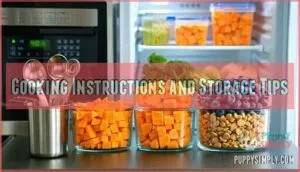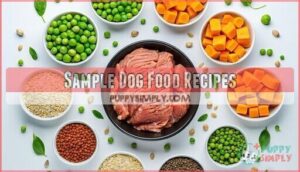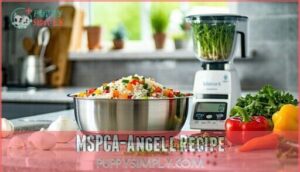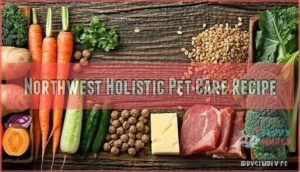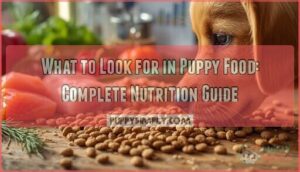This site is supported by our readers. We may earn a commission, at no cost to you, if you purchase through links.

You’ll need to balance proteins, carbohydrates, and essential nutrients—typically 40-50% protein, 30-40% vegetables, and 10-20% grains.
Start with simple combinations like lean ground turkey, sweet potatoes, and spinach, but always consult your vet first since dogs require specific calcium-to-phosphorus ratios and may need supplements.
Switch gradually over 7-10 days to avoid digestive upset, and store portions in the freezer and thaw as needed.
The key isn’t just throwing ingredients together—it’s understanding the precise nutritional balance that transforms kitchen scraps into veterinarian-approved meals.
Table Of Contents
- Key Takeaways
- Fresh Dog Food Basics
- Homemade Dog Food Benefits
- Preparing Homemade Dog Food
- Customizing Dog Food Recipes
- Implementing Fresh Dog Food Diet
- Frequently Asked Questions (FAQs)
- What are the best ingredients to put in homemade dog food?
- Can I make my own fresh dog food at home?
- What is the 25 rule for dog food?
- How do I make sure my homemade dog food has all nutrients?
- Can puppies eat fresh homemade dog food?
- How long does fresh dog food last?
- What vegetables are toxic to dogs?
- Should I add salt to homemade recipes?
- Can diabetic dogs eat fresh food?
- Conclusion
Key Takeaways
- You’ll need veterinary approval before starting – consult your vet to ensure recipes meet your dog’s specific nutritional requirements and get guidance on proper calcium-to-phosphorus ratios and necessary supplements.
- Balance macronutrients precisely – aim for 40-50% protein from lean meats, 30-40% vegetables, and 10-20% grains while avoiding toxic ingredients like onions, grapes, and chocolate.
- Transition gradually over 7-10 days – start with 25% homemade food mixed with your current diet, increasing by 25% every two days to prevent digestive upset.
- Store safely and monitor closely – keep fresh portions refrigerated for 3 days or frozen for 6 months, and watch your dog’s stool consistency, energy levels, and coat quality for signs that the diet is working.
Fresh Dog Food Basics
Making fresh dog food at home puts you in control of your pet’s nutrition and health.
You’ll need to understand canine dietary requirements and work with your veterinarian to create balanced meals that meet your dog’s specific needs.
Nutritional Requirements
Your dog’s nutritional needs mirror a delicate ecosystem requiring precise balance.
Dogs naturally select diets containing 29% protein, 63% fat, and 7% carbohydrates.
Your dog’s instinctive macronutrient wisdom guides optimal fresh food formulations.
Fresh ingredients must provide ten essential amino acids from quality protein sources like lean meats and fish.
Balanced mineral intake, vitamin balance, and adequate dietary fiber support ideal calorie density while meeting your dog’s complete nutritional needs.
A balanced diet should also support immune function to help your dog fight infections and maintain complete nutritional needs with ideal calorie density.
Importance of Veterinary Consultation
Before switching from basic nutritional needs, you’ll want professional guidance to guarantee your homemade meals meet your dog’s specific requirements.
Your veterinarian becomes your most valuable partner in creating vet approved recipes that support peak canine health and nutrition.
- Health assessment – Your vet identifies underlying conditions affecting dietary needs
- Recipe adjustments – Professional guidance ensures proper nutrient ratios for your pet’s age and size
- Supplement integration – Expert advice on necessary vitamins and minerals for complete nutrition
Storage and Portion Control
Proper food preservation keeps homemade meals fresh for three days refrigerated or three months frozen.
Calculate serving sizes using your dog’s weight and activity level—typically one-half to one cup per twenty pounds daily. Maintain consistent ingredient ratios and establish a regular feeding schedule.
Store portions in airtight containers to maximize waste reduction while preserving nutritional facts for your dog food plan. To maintain freshness, consider using a dog food storage container.
Homemade Dog Food Benefits
You’ll discover that making fresh dog food at home gives you complete control over every ingredient your pet consumes, ensuring ideal nutrition while potentially saving money compared to premium commercial brands.
This approach allows you to customize meals specifically for your dog’s unique dietary needs, allergies, and health conditions, which can lead to ideal nutrition.
Nutritional Control and Health
Homemade fresh dog food recipes give you complete control over your pet’s nutrition, addressing specific dietary deficiencies through careful ingredient quality selection.
You’ll know exactly what goes into each meal, ensuring proper nutritional balance without mystery additives or preservatives that commercial foods often contain.
- Monitor ingredient quality by sourcing fresh, whole foods from trusted suppliers
- Implement portioning strategies based on your dog’s weight, age, and activity level
- Address dietary deficiencies through targeted recipe adjustments and nutrient-dense ingredients
- Prioritize hydration importance by incorporating moisture-rich foods and adequate water content
- Create balanced dog meals that support ideal health through consistent healthy dog diet practices
Cost-Effectiveness of Homemade Dog Food
Budget-conscious pet owners discover homemade dog food recipes offer significant Long-Term Savings compared to premium commercial options.
Your wallet stays happy when you skip the premium kibble price tags for homemade meals.
Fresh dog food recipes using strategic Ingredient Sourcing and Bulk Buying can cost $1.21-$1.81 per pound versus expensive specialty brands.
Recipe Optimization with cheap dog food recipe alternatives reduces daily feeding costs while maintaining nutritional quality.
Concerns about ingredients make pet owners seek natural, nutritious options.
Your Time Investment pays off through reduced veterinary expenses and healthier outcomes.
Adjusting Recipes for Individual Dogs
Every dog’s nutritional blueprint differs based on calorie needs, activity level, and health conditions.
You’ll need to adjust portions for a sedentary senior versus an energetic puppy. Consider taste preferences when planning recipe rotation – some dogs prefer chicken while others enjoy beef.
Monitor your dog’s response and modify ingredients accordingly for ideal canine nutrition and balanced dog food results. You can achieve this by ensuring proper nutrient percentages in each meal, which is crucial for balanced dog food.
Preparing Homemade Dog Food
Making homemade dog food requires careful attention to cooking techniques and proper storage methods to guarantee your pet’s safety and nutrition.
You’ll need to follow specific recipes that balance proteins, carbohydrates, and vegetables while maintaining food safety standards throughout preparation.
Cooking Instructions and Storage Tips
When making dog food recipes, cook ingredients to safe internal cooking temperatures—165°F for poultry and 160°F for ground meats.
Practice safe handling by washing hands and surfaces frequently during ingredient prep.
Store fresh food in refrigerator containers for up to three days, or use proper freezing methods for longer shelf life.
To guarantee your dog’s well-being, consider that homemade diets require balance.
Label portions with preparation dates to track meal preparation schedules and guarantee your dog receives the healthiest fresh ingredients consistently.
Sample Dog Food Recipes
Now you’ll find practical dog recipes that work for busy pet parents.
These fresh dog food recipes offer balanced nutrition through simple cooking methods and common ingredients.
Consider these recipe variations to keep meals interesting:
- Basic ground turkey recipe – Combine 1 pound ground turkey, 2 cups brown rice, and mixed vegetables for a complete meal
- Ingredient substitutions – Swap turkey for lean beef or chicken, and replace rice with sweet potatoes for dietary restrictions
- Serving suggestions – Large breeds need 2 cups twice daily, while smaller dogs require portion adjustments based on weight
These healthy dog recipes accommodate various cooking methods from stovetop simmering to slow cooking.
You can find a chewy ground turkey recipe online.
Fresh ingredients for dogs should include lean proteins, complex carbohydrates, and colorful vegetables.
Each recipe provides essential nutrients while allowing flexibility for your dog’s specific needs and preferences.
MSPCA-Angell Recipe
This veterinary-approved fresh dog food recipe uses dark-meat chicken, white rice, and mixed vegetables with essential Balance IT Canine supplement.
Recipe ingredients are precisely portioned for dogs weighing 15, 30, or 60 pounds.
Preparation steps require thorough cooking, accurate weighing, and supplement mixing after cooling.
Many owners also seek pre-made food options for convenience.
This nutritional analysis guarantees complete pet nutrition when following serving suggestions exactly as specified, ensuring a healthy diet.
Northwest Holistic Pet Care Recipe
Switching gears from the MSPCA-Angell approach, the Northwest Holistic Pet Care Recipe puts dog nutrition front and center.
This method uses regional sourcing and focuses on holistic benefits for your pet. Adjust for breed adaptations and preparation variations to fit your dog’s needs.
Try these fresh dog meals for healthy dog food:
- Recipe Ingredients
- Holistic Benefits
- Regional Sourcing
- Preparation Variations
- Breed Adaptations
Customizing Dog Food Recipes
Every dog’s nutritional needs differ based on size, age, and health conditions, making recipe customization essential for ideal wellness.
You’ll need to adjust protein portions, add targeted supplements, and eliminate ingredients that could trigger allergies or toxicity in your specific pet, which is crucial for ideal wellness.
Adjusting Recipes for Breed and Size
Dog breeds require different portions and calorie requirements based on their breed metabolism.
Small dogs need calorie-dense recipes with smaller portions, while large breed dogs require less caloric density to prevent developmental issues.
| Breed Size | Daily Calorie Requirements | Portion Sizes |
|---|---|---|
| Small (10-20 lbs) | 342-576 calories | ¾-1⅓ cups |
| Medium (30-50 lbs) | 781-1,145 calories | 1¾-2⅔ cups |
| Large (60-100 lbs) | 1,313-1,926 calories | 3-4½ cups |
Activity levels substantially impact recipe ratios for healthy dog food formulations, which is crucial for their overall well-being and requires careful consideration of daily calorie requirements.
Adding Supplements and Vitamins
Homemade recipes often lack key nutrients, making supplements essential for complete nutrition.
Research shows 95% of DIY dog food ingredients miss at least one nutrient.
Common deficiency symptoms include weak bones, poor coat quality, and low energy.
Many owners buy supplements from Chewy to address these deficiencies.
Natural sources like liver provide vitamins, while calcium supplements address mineral gaps.
Always consult your vet about vitamin dosage and supplement interactions before adding to healthy diets.
Avoiding Common Allergens and Toxins
Beyond supplementation, you’ll need to navigate the minefield of food sensitivities and toxic ingredients when preparing allergy friendly recipes.
Beef triggers reactions in 34% of allergic dogs, while dairy affects 17%.
Skip chocolate, grapes, onions, and xylitol—they’re dangerous.
Rotate proteins like turkey and fish for healthy ingredients.
Source safe additives carefully, reading labels for harmful preservatives.
This approach creates dog food for sensitive stomach issues while ensuring pet food safety through thoughtful ingredient sourcing.
Implementing Fresh Dog Food Diet
Successfully implementing a fresh dog food diet requires veterinary guidance to guarantee nutritional completeness and avoid deficiencies that could harm your pet’s health.
You’ll need to switch gradually over 7-10 days, mixing increasing amounts of homemade food with your dog’s current diet while monitoring for digestive upset or adverse reactions, which is crucial for a successful transition.
Consulting With a Veterinarian
Before making any recipe changes, schedule a consultation with your veterinarian to discuss dietary concerns and get recipe approval.
Your vet will assess your dog’s health monitoring needs, breed specifics, and supplement needs. They’ll create a personalized dog nutrition guide based on your pet’s medical history.
This professional oversight guarantees your dog diet plan supports peak pet health while addressing any underlying conditions.
Some pet owners are now exploring raw food benefits for their puppies, considering the potential raw food advantages for their dog’s health and overall wellbeing.
Gradually Introducing New Food
Your dog’s stomach needs time to adjust when switching to fresh pet food.
Start with a seven-day Phased Introduction Timeline, mixing 25% homemade dog meals with current food for two days, then 50% for two days, 75% for two days, and 100% fresh on day seven.
Monitor Stool Consistency and watch for Digestive Adaptation signs.
Address Palatability Concerns by warming food slightly.
Continue Allergy Monitoring throughout this gradual switch to your balanced dog diet.
Monitoring Your Dog’s Health and Adjusting Recipes
After establishing your new feeding routine, watch for key Health Indicators that reveal how your dog’s responding.
Monitor Stool Consistency, energy levels, and coat quality for Recipe Tweaks.
Keep an Allergy Watch for itching or digestive upset.
Weight Management becomes easier when you track portions against your pet’s body condition.
Regular dog health monitoring lets you fine-tune your pet nutrition approach perfectly.
Frequently Asked Questions (FAQs)
What are the best ingredients to put in homemade dog food?
You’ll want lean proteins like ground turkey, chicken, or fish as your foundation.
Add brown rice or sweet potatoes for carbs, then mix in vegetables like broccoli, carrots, and spinach for essential nutrients.
Can I make my own fresh dog food at home?
Like nurturing a garden, you can absolutely cultivate homemade meals for your furry companion.
Fresh ingredients including lean proteins, vegetables, and whole grains provide balanced nutrition.
Consult your veterinarian first to guarantee that balanced recipes meet your dog’s specific dietary needs.
What is the 25 rule for dog food?
According to FDA and AAFCO regulations, the 25% rule requires named ingredients to constitute 25-94% of dry weight, excluding processing water.
Foods using this rule must include qualifying terms like "dinner" or "entrée" in their product names.
How do I make sure my homemade dog food has all nutrients?
Consult your veterinarian to create a balanced recipe with proper protein, carbohydrates, fats, vitamins, minerals, and calcium.
Monitor your dog’s weight regularly and adjust portions as needed.
Add veterinary-approved supplements for complete nutrition.
Can puppies eat fresh homemade dog food?
Good things come in small packages" – puppies can eat fresh homemade dog food, but they’ll need smaller portions and more frequent meals.
Their developing digestive systems require careful portion control and veterinary guidance to guarantee proper nutrition.
How long does fresh dog food last?
Fresh homemade dog food stays good for 3-4 days in your refrigerator and up to 6 months frozen.
You’ll want to portion meals into containers and freeze what you won’t use within those few days to keep your pup safe.
What vegetables are toxic to dogs?
You’ll want to avoid onions, garlic, grapes, raisins, chocolate, avocado, mushrooms, and xylitol-sweetened foods. These can cause serious poisoning, kidney damage, or digestive issues in dogs.
Should I add salt to homemade recipes?
No, you shouldn’t add salt to homemade dog food recipes.
While humans crave that salty kick, dogs’ kidneys can’t handle excess sodium like ours can.
Too much salt leads to dehydration, kidney damage, and potentially fatal sodium poisoning in your furry friend.
Can diabetic dogs eat fresh food?
Yes, diabetic dogs can eat fresh food, but you’ll need veterinary guidance for proper carbohydrate management. Fresh meals often provide better blood sugar control than processed kibble when balanced correctly.
Conclusion
Don’t bite off more than you can chew when creating fresh dog food recipes—proper nutritional balance requires careful planning and veterinary guidance.
These homemade meals offer superior ingredient control compared to commercial options, but success depends on maintaining correct protein ratios, essential nutrients, and appropriate supplements.
Monitor your dog’s health closely during switches, store portions safely, and remember that fresh dog food recipes aren’t just about wholesome ingredients—they’re about creating complete, balanced nutrition your veterinarian can confidently recommend for your pet’s long-term health.
- https://dogchild.co/blogs/learn/science-backed-benefits-of-home-cooking-for-your-dog
- https://blog.myollie.com/health-benefits-of-fresh-natural-diet-for-dogs/
- https://www.petmd.com/dog/nutrition/evr_dg_whats_in_a_balanced_dog_food
- https://perfectlyrawsome.com/raw-feeding-knowledgebase/nrc-nutritional-requirements-for-adult-dogs/
- https://www.chewy.com/education/dog/food-and-nutrition/how-much-fresh-food-to-feed-a-dog


